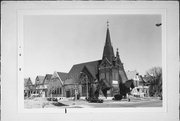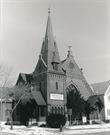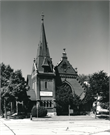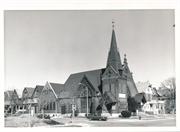| Additional Information: | DESCRIPTION:
The Highland Avenue Methodist Church is a distinctive single-towered German Gothic church of irregular cruciform plan built for Milwaukee's first German Methodist Congregation in 1891. The principal or Highland Avenue facade features a broad low gable with hooded entry to the east and a low, squat tower to the west. The tower is broken into several horizontal registers by a band of arched openings at the lower level and a single vertical window above. A stone plaque between the two elements once read "Erste Deutsche Bischofliche Methodisten Kirche" but is now covered with a sign that reads Solomon Community Temple. Corbelling and decorative brick work in diamond pattern ornament the tower at the base of the spire. The steeple makes the transition from square to octagonal by splitting into one large and four small spires. Two parapet-like gables with occuli abut the steeple on the east and west faces. The primary wall of the church's main facade is dominated by a traceried stain-glass window. The topmost section of the gable features an occulus, crockets and crosses. The two windows are separated by a corbelled band of the same type as used on the tower, thus unifying the tower and the main body of the church. The west facade also features a large, traceried window. A hooded entrance supported by columns is located at the tower and a smaller, unornamented entrance is situated to the north. A gabled addition at the north end of the structure runs perpendicular to the main body of the church. The building is in excellent condition.
The nave is almost square in plan and of the Akron type in which the pews are arranged in a series of concentric segmental curves focusing on the raised dais at the corner of the nave containing the lectern, communion table and choir.
ARCHITECTURAL/ENGINEERING SIGNIFICANCE:
Normally religious properties are excluded from listing in the National Register, but the Highland Avenue Methodist Church is architecturally significant as an example of the German Gothic style in Milwaukee. Two other churches in Milwaukee were built in this style and have suffered losses of integrity, unlike Highland Avenue, which remains largely intact. Local architectural historian Richard Perrin notes that the use of terra cotta with brick as in Highland Avenue Methodist had its origins in the North German Gothic churches of the 15th century. Despite the large German population in Milwaukee, this style is rare.
Highland Avenue Methodist Church, designed by the firm of Crane and Barkhousen, was the first of Milwaukee's German Gothic Churches, built in 1891. Friedens Evangelical, also on the West Side, was built in 1905 and Grace Lutheran was built in 1900 in today's central business district. All three were constructed for German-speaking congregations and all three were mother churches of their denomination: Grace Lutheran for Wisconsin Synod Lutheranism, Friedens for the Evangelical-Reformed (now the United Church of Christ) and Highland Avenue Methodist for German Methodism.
Highland Avenue Methodist Church is the smallest of the three and the most unique as well as most intact. Both Friedens and Grace Lutheran feature twin towers of unequal height flanking central, triple-openings porticos. The Highland Avenue Church has only one tower, and has entries to the side and in the tower protected by gabled hoods with bargeboard trim. Friedens and Grace Lutheran both make use of a more traditional ground plan with nave and transept. The Highland Avenue Church, however, has a more centralized plan with a short transept and almost square interior space. Grace Lutheran has suffered the loss of its terra cotta finials at the base of each spire and Friedens lost its west spire due to storm damage several years ago. Highland Avenue Methodist, in contrast, remains intact and its north addition, built approximately 1907, does not mar the integrity of the structure.
Highland Avenue Methodist Church is the only known ecclesiastical structure done by the firm of Crane and Barkhausen in Milwaukee. The firm chiefly designed residences or schools (German-English Academy 1890, and Friendens School 1896). The Highland Avenue Church is typical of their German influenced buildings of the 1890s. Builder was Charles Maier and Son.
HISTORICAL BACKGROUND:
The mother church of German Methodism in Wisconsin was the Highland Avenue Methodist Church at 2064 West Highland. German Methodism in America had begun in the 1830's and was administered separately from English speaking congregations through a German Conference, one branch of which coordinated activities in Wisconsin, Illinois and the Northwest. By 1916 German Methodists represented approximately 28% of all Methodists in Milwaukee. It was not until 1933 that the German and English conferences consolidated.
Milwaukee's first German Methodist congregation was established in 1846 at a site on the banks of the Milwaukee River south of the present Kilbourn Avenue bridge. In 1848 a brick chruch was built on North 5th Street but it was replaced with a new brick sanctuary in 1872 at the southeast corner of West Juneau Avenue and 11th Street. This structure was sold to the adjacent Pabst Brewing Company in 1896 when the congregation moved further west to the northeast corner of 21st Street and Highland Avenue. The congregation changed its name to Highland Avenue Church and began to serve the community with English language services. The Highland Avenue church was responsible for the founding of Milwaukee's five other German Methodist congregations. After World War I, it merged with the congregation of the Third German Methodist Church and the resulting congregation met at the Highland Avenue church.
In the 1960s the Highland Avenue Methodist Church disbanded. The building subsequently reverted to the Methodist-Episcopal Conference. Attempts to convert the church into a community center were unsuccessful and it was eventually occupied by a black congregation. In 1970 a new congregation, the Church for All People, moved into the building. A few years later it merged with a Black Methodist Congregation to become the Solomon Community Temple which still occupies the old Highland Avenue Church. (B, D, E, F).
HISTORICAL SIGNIFICANCE:
The Highland Avenue Methodist Church is of statewide historical significance. Founded in 1846, it was the mother church of German Methodism in Wisconsin. Begun by Reverend William Schreck, a missionary pastor from Quincy, Illinois, it spawned other German Methodist congregations, including five in Milwaukee and others in West Bend, Watertown, Manitowoc, Oshkosh, Columbus and Wausau. The Highland Avenue church building was the fourth and last structure of the congregation. Originally known as the German Methodist Church (1846-1869) and then as the First German Methodist Episcopal church (1870-1894) its name was changed to Highland Avenue Methodist when it moved to this site in 1894. This name change reflected the addition of English language services, even though the congregation remained in the German Methodist conference until 1933, when the latter merged with the English conference. (B, F). |
|---|
| Bibliographic References: | A. Milwaukee City Building Permits.
B. Colver, J. Newton, ed. "One Hundred Years of Methodism In Greater Milwaukee." Milwaukee: General Committee of Milwaukee's Methodist Centennial, 1935, pp. 30-31.
C. Perrin, Richard W.E., "Milwaukee Landmarks." 2nd. ed. Milwaukee Public Museum Publication in History No. 9. Milwaukee: Milwaukee Public Museum, 1979, pp. 28-29.
D. Wisconsin Inventory of Historic Places. Notes on the First German Methodist Church.
E. Young, George W. and Powell, Rees E., comp., "Historical Review of Grand Avenue Methodist Episcopal Church, 1836 to 1916.
F. Bennett, A.M., P.S., Rev. and Lawson, James, Rev. "History of Methodism in Wisconsin." Cincinnati: Cranston & Stowe, 1890, pp. 453-55. |
|---|





